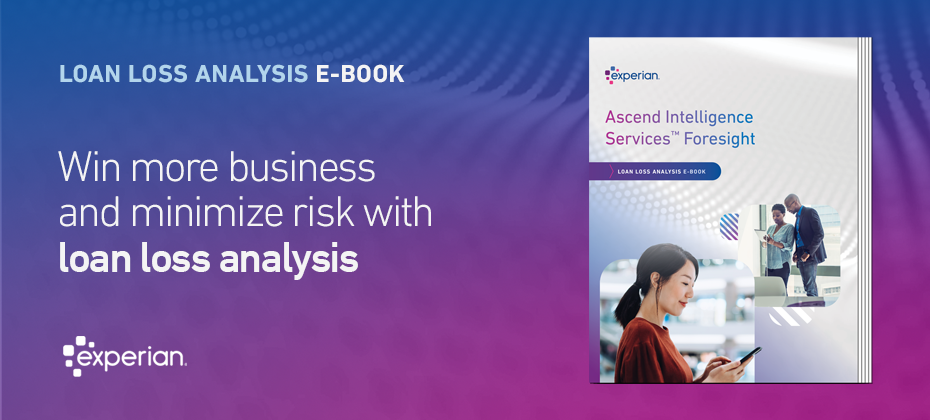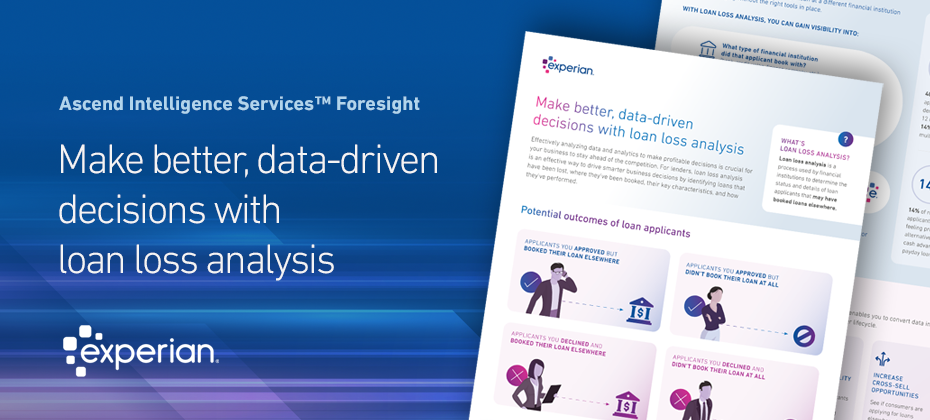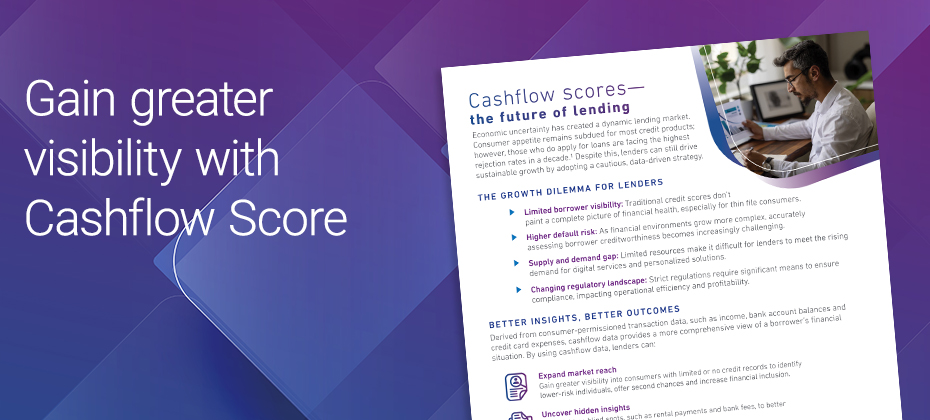Latest Posts

Managing credit limits effectively can be a game-changer for both consumers and financial institutions. Understanding the benefits and behaviors associated with increased credit limits helps in appreciating the long-term impacts of this strategy. Proactive credit limit management offers numerous advantages that can significantly improve financial health and stability.

Vehicle price. Monthly payment. Loan terms. Interest rates. Those are the more prominent buzz words dealers hear from consumers throughout the vehicle shopping process, particularly in our current environment. And rightfully so, in-market shoppers are hoping to get the most value for their wallets. But let’s not forget how valuable transparency can be, especially with used vehicles. Hidden damage from accidents or natural disasters, as well as title brands, among other factors, can have a significant negative impact on the drivability of any given vehicle. Ensuring consumers have visibility to that information can help them make a more informed purchasing decision, and more importantly, help dealers potentially build a lifelong relationship with them. Plus, consumers want that information. According to a recent Experian survey [1], nearly all respondents (98%) said a vehicle history report is important to them when considering the purchase of a used vehicle. Furthermore, almost 70% said accident history information in a report would likely influence their purchasing decision, followed by frequent repairs (61%) and title problems such as salvage or flood damage (55%). Given the significance of used vehicles in the automotive market, having tools such as Experian AutoCheck® vehicle history reports readily available on dealership and manufacturer websites can help buyers make more informed decisions. Where today’s consumers start their vehicle search Knowing what resources consumers are using to search for their next vehicle plays a role in identifying where they’re gathering their information, and in turn, can help guide dealers in offering relevant information during the decision-making process. The survey revealed that 64% of consumers browse dealership websites and 46% look at manufacturer websites during their buying process. In a competitive market, having instant access to a vehicle’s history can help streamline the shopping experience while allowing buyers to feel more confident and drive conversions. Leveraging this information will allow businesses to tailor their consumer engagement strategies to meet the specific needs or concerns of potential buyers at each stage of the journey. [1] Experian commissioned Atomik Research to conduct an online survey of 2,005 adults throughout the United States. The sample consists of adults who estimate they will purchase or lease their next vehicle within the next 24 months or sooner. The margin of error is +/- 2 percentage points with a confidence level of 95 percent. Fieldwork took place between March 24 and March 27, 2025.

Managing credit limits effectively is vital for maintaining a profitable and resilient credit card portfolio. By adopting a proactive credit limit management approach, financial institutions can significantly improve customer satisfaction and increase revenue. As of Q3 2024, the average credit card limit in the U.S. stood at $32,025, marking a 4.1% rise from $30,763 the previous year.1 Proper management of these limits is crucial for financial institutions, as it impacts consumer borrowing capacity and overall financial health. Advantages of proactive credit limit increases A proactive credit limit increase occurs when a credit card issuer raises a cardholder’s credit limit without their request. This action is usually dependent on improvements to cardholders’ creditworthiness, including consistent, on-time payments and a reduction in debt. Proactive increases can enable financial institutions to: Increase interchange income: When financial institutions increase credit limits, they can boost transaction volumes, leading to higher interchange income. Generate additional interest income: Higher credit limits can lead to increased borrowing, resulting in more interest income for financial institutions. Enhance wallet share: By proactively increasing credit limits, institutions can encourage cardholders to use their cards more frequently, thereby increasing wallet share. Reduce customer attrition: When cardholders feel valued and supported, they are more likely to remain loyal to their financial institution. Proactive credit limit increases can reduce attrition rates by enhancing customer satisfaction and loyalty. Improve customer experience: Cardholders value the convenience and flexibility of higher credit limits, which can lead to increased satisfaction, positive sentiment and potential referrals. Implementing proactive credit limit increases To successfully implement proactive credit limit increases, financial institutions must address two key questions: Who receives an increase? Use insights to identify cardholders who meet the criteria for credit limit increases. Continuously monitor cardholders’ creditworthiness using advanced tools and technologies to ensure that only responsible cardholders receive increases. How much of an increase? Determine customers’ ability to afford additional credit by evaluating their annual income, debt-to-income ratio, and payment-to-income ratio. Set thresholds for these metrics to guide the decision-making process. Proactive credit limit management Effective credit limit management is essential for financial institutions aiming to grow their credit card portfolios and enhance customer satisfaction. Read this e-book on proactive credit limit management and discover how your institution can improve wallet share, enhance customer experience, and drive revenue. Read the e-book 1 Experian, Average Credit Card Debt Increases 3.5% to $6,730 in 2024.

Electric vehicles (EVs) continue to gain traction in certain markets. In fact, at the end of 2024, 9.2% of all new retail registrations were electric, up from 8%+ in 2023 and 6%+ in 2022. Clearly, more and more in-market shoppers are leaning towards EVs, but what is actually a determining factor in their decision? A recent Experian survey [1] found 65% of respondents said they prioritize battery life, while 62% consider price, 58% are concerned with range on a full battery and 53% are focused on infrastructure and maintenance. It’s not just EVs, hybrids are getting into the mix While EVs certainly are the buzzword in the industry, it’s not the only alternative fuel type consumers are opting for. For instance, 55% of respondents said they’d consider a new hybrid and 50% said they’d consider a new EV for their next vehicle purchase. On the used side, 38% of respondents said they’d consider an EV and 42% would consider a hybrid. More granularly, the survey revealed 67% of Gen Z and 61% of Millennials are likely to buy a new EV, while 62% and 63% of these groups, respectively, expressed similar intentions for purchasing new hybrid. Gen Z and Millennials also showed a stronger-than-average interest on the used side, with 57% and 49% opting for EVs, and 57% and 52% choosing hybrids. With the younger generations gravitating towards these fuel types, it’s likely going to influence adoption rates down the road, a trend that should be watched closely as manufacturers roll out more models to meet the growing demand. However, when assessing the viewpoints of other generations, some are less likely to purchase an alternative fuel type. Two-in-five, albeit still a healthy percentage, of Gen X respondents said they’re likely to purchase a new EV and only 25% of Baby Boomers shared a similar sentiment. Meanwhile, 27% of Gen X and 12% of Baby Boomers say they’re likely to purchase a used EV. Furthermore, 46% of Gen X and 43% of Baby Boomers indicated they are likely to buy a new hybrid, while 33% and 21% of these groups, respectively, conveyed similar thoughts towards purchasing used hybrids. It’s crucial for professionals to stay attuned to shifting trends and concerns among consumers, as these factors play a role in consumer decision-making. By addressing potential setbacks and knowing where their target audience is, they can better align their strategies with consumer needs as these fuel types continue to move up on the list for everyday commuters. [1] Experian commissioned Atomik Research to conduct an online survey of 2,005 adults throughout the United States. The sample consists of adults who estimate they will purchase or lease their next vehicle within the next 24 months or sooner. The margin of error is +/- 2 percentage points with a confidence level of 95 percent. Fieldwork took place between March 24 and March 27, 2025.

As telecommunications providers race to modernize networks, enable 5G, and manage soaring data volumes, they also face unprecedented challenges – from tightening regulations and economic uncertainty to increasing customer churn and fraud. In this climate, artificial intelligence (AI) in telecommunications isn’t just a buzzword; it’s becoming a cornerstone for strategic survival and competitive differentiation. But the promise of AI is only as powerful as the data that fuels it and the decisions it enables. In this blog post, we explore the pressing challenges telecom providers face, including the evolving economic and regulatory landscape, and how Experian’s telecom solutions are uniquely equipped to support telecom leaders using advanced analytics, data-driven decisioning, and fraud prevention solutions. The current state of telecommunications: a perfect storm Telecom providers are under pressure from multiple angles: Shrinking ARPU and rising competition Average Revenue Per User (ARPU) is declining in many regions as price competition increases and Over-the-Top (OTT) services continue to displace traditional service lines. In North America alone, mobile ARPU has dropped by more than 8% in recent years1. Customer experience expectations Modern customers expect seamless digital experiences. Yet, legacy systems and data silos often prevent real-time personalization and service optimization, increasing churn risk2. Regulatory scrutiny and data privacy Telecoms must comply with a complex web of data protection and privacy regulations (GDPR, CCPA, KYC, etc.) while also navigating policies around fair access, net neutrality, and cross-border data flow3. Fraud and credit risk The growing prevalence of synthetic identity fraud and account takeovers demands more robust, intelligent fraud prevention and credit risk strategies, especially in prepaid and postpaid customer segments. In 2023, synthetic identity fraud caused more than $2.6 billion in financial damage globally4. The role of advanced analytics and AI in telecommunications Against this backdrop, AI and telecommunications are becoming increasingly intertwined. By leveraging AI and advanced data analytics, telecom operators can move from reactive to proactive operations. This includes: Churn prediction and mitigation using machine learning. Network optimization through AI-driven traffic forecasting. Fraud detection via real-time anomaly detection models. Credit risk modeling with AI-powered segmentation. However, not all AI solutions deliver the same level of impact. For telecom providers, challenges like fragmented data ecosystems, model governance, and the need for explainable outcomes—especially in highly regulated environments – can limit AI’s full potential. Only Experian can: solving telecom’s data and decisioning challenges This is where Experian stands out. As a trusted leader in data and decisioning, Experian provides telecoms with scalable, regulatory-compliant tools that can help accelerate digital transformation. Purpose-built telecom solutions Our telecom solutions are designed specifically to address sector pain points like fraud, credit risk, and customer churn. Whether you're a traditional mobile network operator (MNO) or a disruptive MVNO, Experian can help you make smarter decisions—faster.'Our telecom solutions are designed specifically to address sector pain points like fraud, credit risk, and customer churn. Whether you're a traditional mobile network operator (MNO) or a disruptive MVNO, Experian can help you make smarter decisions—faster. Advanced analytics expertise Experian helps telecoms harness the power of advanced analytics to make sense of complex, high-volume data. From customer segmentation to behavioral modeling, our tools bring clarity and actionability that unlock new value from existing data. Predictive modeling solutions that drive results With our specialized predictive modeling solutions, telecoms can implement next-best-action strategies across acquisition, onboarding, and retention. These models are tested, explainable, and auditable—ensuring compliance while delivering ROI. Robust fraud and identity capabilities With rising fraud threats including synthetic identity and account takeovers, Experian can deliver AI-enhanced, layered fraud prevention strategies. Our tools detect anomalies in real-time, leveraging fraud analytics and behavior-based risk signals, helping you reduce losses without adding friction to the customer experience. Scalable, future-ready advanced analytics solutions Our full suite of advanced analytics solutions enables telecoms to future-proof their operations, ensuring they stay compliant while innovating faster than competitors. Data-driven innovation: use cases Here’s how telecoms are already seeing ROI with Experian: A leading North American communications company retained 30% of revenue by implementing Experian Optimize to improve the growth and retention of customers. A multichannel media company used Experian’s solutions to drive a customer-focused approach to campaign planning resulting in a 35% increase in customer revenue without increasing marketing spend. A European wireless telecom provider optimized collections allocations, segmenting customers by demographic and behavioral groups to provide a higher rate of reconnections. Results included a 10% increase in net customer value, a 15% increase in balance collected and a 9% increase in collections agency earnings. Navigating what’s next in telecom The future of AI in telecommunications is promising for providers who can bridge the gap between AI aspiration and execution. Telecommunication providers must not only adopt the right technologies but also partner with trusted data stewards who understand the regulatory, economic, and operational landscape. We’re that partner. At Experian, we help telecom leaders go beyond surface-level insights to power meaningful outcomes, whether that’s to drive smarter acquisition, stronger client retention and faster innovation. Our solutions are grounded in trusted data and measurable outcomes. The pressure on telecoms isn’t going away. But with the right AI-powered tools and data-driven strategies, providers can shift from playing defense to leading with innovation. Now is the time to rethink how you approach data, risk, and customer engagement. Ready to see how Experian can help your telecom organization unlock the power of AI and advanced analytics? Explore our telecom solutions or contact an Experian expert to start transforming your strategy today. Learn more Partner with our team

The necessity of integrated feature management Feature engineering is essential for financial institutions to identify valuable features that provide significant insights and predictive power in various analytics applications. By integrating feature engineering into the feature lifecycle, organizations can convert raw data into more accurate and value-driving features, better manage features for audit purposes and compliance efforts, and build higher-performing models. At Experian, we have developed a unified feature engineering solution that integrates capabilities across various tools such as the Ascend Analytical Sandbox™ and Ascend Ops™. This comprehensive approach streamlines the feature engineering process, making it more efficient and effective in supporting the complete feature lifecycle. The challenges in feature engineering 54% of source data used by financial institutions for credit decisioning is not model-building ready.1 Financial institutions need access to high-quality data sources and the ability to modify and combine data to make more profitable data-driven decisions. In addition, organizations need the necessary tools to solve the myriad of challenges involved with feature engineering. These challenges include: Costs: Sourcing and centralizing data can be expensive, and managing and updating data definitions for engineering and analytics is costly. Collaboration: Managing a centralized feature library is difficult and often skipped. As AI and analytics teams become more complex across the enterprise, maintaining and governing feature definitions in a centralized library is a must-have. Inconsistencies: Calculating features can vary. Different calculations in development and production use cases across the lending lifecycle create model risks and compliance issues. Governance risks: Tracking lineage of data definitions is important to avoid elevating risks. Data engineers and scientists need to visualize upstream and downstream impacts as they modify feature definitions. Resources: Teams often have skills gaps and require additional expertise, as they may lack an understanding of automated credit reports amongst resources. Integration: Evaluating and integrating features into the analytics lifecycle is difficult. This can hinder understanding of the value of models and strategies throughout the lending lifecycle and create friction at deployment. Experian Feature Builder: a comprehensive solution Experian Feature Builder is a modern, integrated custom feature solution that combines development, deployment, and management technologies. It accelerates the feature lifecycle through efficient data management and streamlined end-to-end workflows. Users can access the Ascend Analytical Sandbox for custom feature development and seamless connection to Ascend Ops for deployment and ongoing management. This integration also significantly enhances compliance and governance by adding a layer of visibility into feature performance, thereby reducing risks through feature monitoring. Leveraging best-in-class technologies Feature Builder Notebooks enables users to review feature code in Jupyter Notebooks within Ascend Analytical Sandbox, explore data, execute small sample feature calculations, examine feature distributions, edit feature code, and register to the feature library. Feature Builder Studio enables users to review and manage features in the feature library, set up feature calculation jobs, and define feature sets for deployment. Users can also add Ascend Ops to deploy to production with little to no friction. Supporting advanced analytics in consumer credit with integrated feature management Experian Feature Builder provides a centralized feature library, ultimately improving time to market and decisions to extend credit while managing default and fraud risks. Centralized access to data sources used in custom features and intermediation of third-party data sourcing. Advanced lineage tracking for a clear view of the history of upstream and downstream feature dependencies for governance purposes. Streamlined feature registry for built-in version management and tracking with feature correlations and distributions. Key statistical reporting for out-of-the-box data visualizations and monitoring of feature correlations and distributions. Comprehensive feature lifecycle support through integration with Ascend Analytical Sandbox for rapid analytics use case iteration and experimentation as well as production-grade execution and deployment with Ascend Ops. The future of feature engineering Understanding how essential feature engineering is in producing value-driving features, managing and monitoring features for audit and compliance purposes, and more predictive and high-performing models is pivotal to maintaining competitiveness in the financial services industry. Experian Feature Builder is the future of feature engineering. With integration for advanced analytics, model development through deployment, and enhanced feature management capabilities supporting compliance and governance, Experian Feature Builder supports the complete feature lifecycle. To learn more about how Experian Feature Builder can revolutionize your feature engineering, please visit our website and book a demo with your local Experian sales team. Learn more about Feature Builder 1 Experian research 2023

Lending institutions need to use the right business strategies to win more business while avoiding unnecessary risk, especially regarding lending policies. A recent study revealed that 48% of American loan applicants have been denied over the past year, with 14% facing multiple rejections. Additionally, 14% of rejected applicants felt pressured to seek alternative financing like cash advances or payday loans.1 These statistics highlight the need for financial institutions to offer attractive loan options to stay ahead in the industry. Understanding loan loss analysis Loan loss analysis is a powerful tool that helps lenders gain insights into why applicants book loans elsewhere. Despite efforts to target the right consumers at the right time with optimal offers, applicants sometimes choose to book their loans with different institutions. The lack of visibility into where these lost loans are booked can hinder a lender’s ability to improve their offerings and validate existing policies. By leveraging loan loss analysis, lenders can turn valuable data into actionable insights, creating more profitable business opportunities throughout the entire customer lifecycle. Gaining deep consumer insights Loan loss analysis provides visibility into various aspects of competitors’ loan characteristics, such as: Type of financial institution: Identifying whether applicants prefer banks, credit unions or finance companies can help lenders tailor their offerings. Average loan amount: Understanding how much other institutions offer allows lenders to adjust their loan amounts to be more competitive. Interest rates: Comparing interest rates with competitors helps lenders calibrate their rates to attract more business. Loan term length: Knowing the term lengths offered by competitors can inform decisions on loan terms to make them more appealing. Average risk score: Determining the risk scores of loans booked elsewhere helps lenders optimize their policies to maximize earning potential without increasing default risk. Making profitable decisions with business intelligence Experian's loan loss analysis solution, Ascend Intelligence Services™ Foresight, offers comprehensive insights to help lenders: Book more loans Increase profitability Enhance acquisition strategies Improve customer retention Optimize marketing spend By determining where applicants ultimately book their loans, lenders can unlock deep insights into competitors’ loan characteristics, leading to more intelligent business decisions. Read our latest e-book to discover how loan loss analysis can help you gain visibility into competitor offerings, improve your lending policies, book higher-performing loans, and minimize portfolio risk. Read the e-book Visit our website 1 Bankrate, February 2025. Survey: Almost half of loan applicants have been denied over the past 12 months.

Customer retention is crucial for lenders to maximize lifetime value, especially during economic uncertainty. Increasing customer retention rates by just 5% can boost profits by 25% to 95%. However, many lenders struggle with loyalty, as seen in Q2 2024 when mortgage servicers’ retention rates for refinances dropped to 20%, the second lowest in 17 years. Nonbanks and banks also saw significant declines. This is due to increased competition, changing economic conditions, and a lack of personalization. Key strategies for improving customer retention Lenders can improve retention by leveraging data for personalization, maintaining consistent communication, offering loyalty rewards, and utilizing retention triggers. Leverage data for personalization. Use customer data to offer tailored products and refinancing options based on financial behaviors. Using credit attributes, trended data and alternative credit data (alternative financial services data, cashflow attributes, etc.) can help provide deeper insights of your customers. Maintain consistent communication. Keep customers informed with regular updates about interest rate changes or new loan products. Use a variety of communication channels, including email and in-app messaging, to ensure customers are kept in the loop. Ensure your customer service team is always available and responsive, offering clear answers to any financial concerns. Offer loyalty rewards. Develop programs that reward repeat business and referrals. Offer special rates or discounts for returning customers or for those who refer friends and family to your services. Increase customer lifetime value (LTV) by offering additional services like financial planning or credit score monitoring. Utilize retention triggers. Identify key events for engagement with automated retention triggers. For example, a borrower who has a mortgage with a fixed rate may be less likely to consider refinancing unless prompted. Experian’s Retention TriggersSM can notify lenders when refinancing might be beneficial to their customer, offering them personalized incentives or new product options at the right time. Why Experian’s Retention Triggers? By integrating Experian’s Retention Triggers, lenders can keep borrowers engaged, increase retention, and boost profitability even in tough economic times. Advanced data insights: Gain deeper insights into your customers’ behavior to identify those at risk of leaving and take proactive action. Personalized engagement: Automate personalized communications based on customer behaviors, ensuring timely engagement. Increased revenue: By offering personalized, timely and relevant offers, you can increase the likelihood of retaining your customers and growing your revenue. Make customer retention a priority In today’s challenging economic climate, lenders who focus on personalized experiences, consistent communication, and relevant offers will stand out and retain borrowers. Leverage tools like Experian’s Retention Triggers to proactively engage customers, reduce churn, and foster long-term relationships for increased profitability and success. Learn more

Loan loss analysis helps financial institutions identify the characteristics and performance of loans that have been lost to competitors.

GenAI is pushing financial institutions to focus on improving efficiency, productivity, and time to value during the modeling lifecycle. Experian Assistant provides robust tools for data exploration, model building, deployment, and performance monitoring, allowing users to drive better decision-making.

Consumers are experiencing the highest loan rejection rates in a decade, driven by strict lending standards.1 While crucial for mitigating risk, these measures can also limit growth opportunities for financial institutions. Our latest one pager explores how cashflow data, obtained from consumer-permissioned transaction data, empowers lenders with unique insights into consumers’ financial health, enabling them to expand their portfolios while managing risk effectively. Read the full one pager to learn how cashflow data can help you make smarter, more confident lending decisions. Access one pager 12024 Q4 Lending Conditions Chartbook, Experian.

While many industry pundits are assessing how macroeconomic changes may impact the future of the automotive market, recent data suggests consumers tend to stick to specific fuel types. According to Experian’s Automotive Market Trends Report: Q4 2024, over the last 12 months, 77.5% of electric vehicle (EV) owners replaced their EV with another one, with 15.6% returning to gas-powered vehicles. Meanwhile, 82.2% of gas vehicle owners replaced it with the same fuel type, while only 4.7% made the switch to electric. It’s important for professionals to recognize that most consumers tend to replace their vehicles with the same fuel type. Additionally, knowing who is making these purchases and the types of vehicles being registered allows better anticipation for consumer needs and ultimately enhances the buying experience while fostering consumer loyalty. Breaking down fuel types by generation Through Q4 2024, Baby Boomers predominantly registered new gasoline vehicles, accounting for 74.7% of their choices, while 15.9% opted for hybrids and 6.6% chose EVs. Millennials showed a similar trend, with 69.2% registering gas vehicles, followed by 15.1% selecting hybrids and 12.5% choosing EVs. Gen Z also favored gasoline vehicles at 74.0%, with hybrids making up 14.3% and EVs at 9.1% of their registrations. Although gasoline vehicles account for the majority of new registrations, EVs and hybrids are steadily gaining ground, particularly among the younger generations who are drawn to advanced features that align with their preferences. This will likely play a role in shaping the future of vehicle registrations as more gas alternative models hit the market and consumers make the switch. To learn more about vehicle market trends, view the full Automotive Market Trends Report: Q4 2024 presentation on demand.

Many organizations remain committed to financial inclusion to create better outcomes for underrepresented consumers and small businesses by unlocking barriers to financial well-being and closing the wealth gap. Organizations like credit unions, Community Development Financial Institutions (CDFIs), and Minority Deposit Institutions (MDIs) live by these values. These lenders work hard to ensure these values are reflected in the products and services they offer and in how they attract and interact with customers. While funding from the federal government is being scaled back for many of these community-based financial institutions, Experian is scaling up! We're still here to support CDFIs, Credit Unions, and their members, along their financial inclusion journey. The cross-walk between DEIB and financial inclusion Although Diversity, Equity, Inclusion and Belonging (DEIB) and financial inclusion involve different strategies, there’s an undeniable connection that should ultimately be tied to a business’s overall goal and mission. The communities that are historically underrepresented and underpaid in the workforce – including Black Americans, Hispanic/Latinos, and rural white Americans – also tend to be marginalized by the established financial system. Financial institutions that work to address the inequities within their organizations and promote financial inclusion may find that these efforts complement each other. DEIB policies help promote and support individuals and groups regardless of their backgrounds or differences. While financial inclusion is less specific to a company or organization, instead it describes the strategic approach and efforts that allow people to affordably and readily access financial products, services, and systems. The impact of financial inclusion Lenders can promote financial inclusion in different ways. A bank can change the requirements or fees for one of its accounts to better align with the needs of people who are currently unbanked. Or it can offer a solution to help people who are credit invisible, or unscoreable by conventional credit scoring models, establish their credit files for the first time. Financial institutions also use non-traditional data scoring to lend to applicants that conventional scoring models can’t score. By incorporating alternative credit data[1] (also known as expanded FCRA-regulated data) into their marketing and underwriting, lenders can expand their lending universe without taking on additional risk. Financial inclusion efforts for all Experian is a champion of financial inclusion by supporting both financial institutions and consumers. Through our Inclusion Forward – Experian Empowering Opportunities™ initiative, we work directly with lenders to reach underserved communities and extend greater credit access to consumers. We also offer various tools to help consumers build and understand their credit, and to help financial institutions reach underrepresented communities. We provide individuals with everything from financial inclusion solutions to literacy education to insights about their own financial profile, along with ways to help underrepresented communities improve their financial wellness.* One way that we are doing this is through our consumer programs called Experian Go® and Experian Boost® –that are available for free through the Experian app. These first-of-their-kind programs work together to help consumers improve their credit profile. Experian Go helps individuals establish a credit file, while Experian Boost assists with adding tradelines to an existing credit file. For example, with Experian Boost, individuals can connect positive payments to utility, rent, streaming services, and other accounts to improve their credit scores. Membership with Experian helps consumers monitor their credit, manage their money, and find ways to save money, including shopping for insurance. In fact, consumers saved an average of $828 per year when they switched and saved through Experian Insurance Marketplace.[2] Working together to create financial empowerment There’s no magic solution to undoing the decades of policies and prejudices that have kept certain communities unable to fully access our financial and credit systems. But financial institutions like credit unions, CDFIs and MDIs take steps every day to drive financial inclusion and help underrepresented communities. These values are a part of their business DNA, and Experian is here to help keep their legacy alive. Whether you’ve established your strategy or need help with implementation, we can help you enhance your financial inclusion efforts. Learn more about our helpful solutions. Experian will point you in the right direction to business growth. Visit our website [1] Using Alternative Credit Data for Credit Underwriting. [2] Experian research. *Experian Boost: Results will vary. Not all payments are boost-eligible. Some users may not receive an improved score or approval odds. Not all lenders use Experian credit files, and not all lenders use scores impacted by Experian Boost. Learn more.

In the latest episode of "The Chrisman Commentary" podcast, Experian experts Ken Tromer, Director, Mortgage Market Engagement, and Ted Wentzel, Senior Product Marketing Manager, talk about why price transparency is important in the verification process, and how Experian Verify ensures it. Listen to the full episode for all the details and tune in to the previous episode to learn more about reducing mortgage pipeline fallout and improving loan pull-through rate. Listen to podcast

While CUVs and SUVs continue to dominate the market, sedans remain a popular choice among consumers. According to Experian’s Automotive Consumer Trends Report: Q4 2024, sedans accounted for 18.4% of new retail registrations and 36.9% of used. Comparatively, CUVs/SUVs came in at 59.3% for new and 38.6% for used. For retail sedan registrations, the Toyota Camry made up the most market share for both new and used in the last 12 months, coming in at 10.5% and 6.0%, respectively. Meanwhile, the Honda Civic came in a close second for new sedan registrations at 10.1% and the Honda Accord followed closely for used at 5.9%. Knowing which sedan models are leading in registrations is important for professionals as it helps them understand evolving consumer preferences, enhance marketing strategies, and make informed inventory decisions. Understanding the key generations fueling the sedan segment When examining generational interest in this vehicle segment, data found Gen Z and Millennials over-indexed in new retail sedan registrations. In the past 12 months, Gen Z represented 12.4% of new retail sedan registrations, while their total new retail registration was 8.2%. Millennials had 27.3% of sedan registrations out of 27% total registrations. Understanding who is purchasing and what models they’re gravitating towards can unlock valuable insights as professionals craft their next move and position themselves one step ahead in a competitive market. To learn more about sedan insights, view the full Automotive Consumer Trends Report: Q4 2024 presentation.